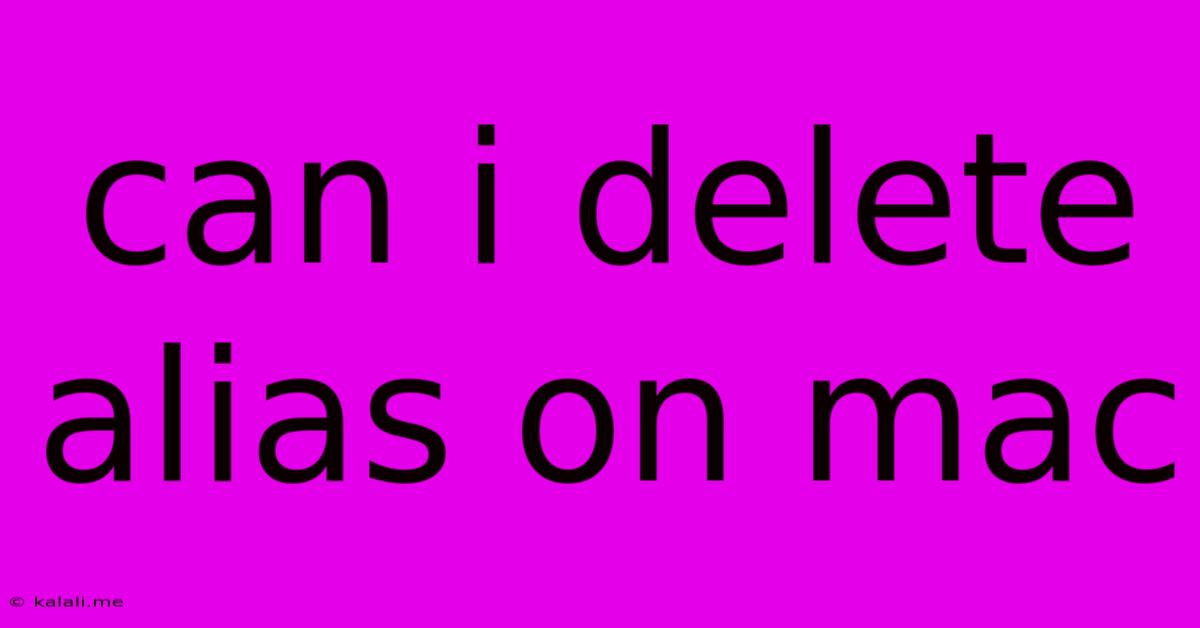Can I Delete Alias On Mac
Kalali
Jun 07, 2025 · 3 min read

Table of Contents
Can I Delete an Alias on My Mac? A Comprehensive Guide
Deleting aliases on your Mac is a simple process that can help declutter your system and improve organization. This guide will walk you through how to safely remove aliases, explain what they are, and offer some troubleshooting tips if you encounter any issues.
What is a Mac Alias?
Before diving into deletion, it's important to understand what an alias actually is. An alias is essentially a shortcut or pointer to another file or folder on your Mac. Think of it like a Windows shortcut or a symbolic link in Linux. It doesn't contain the actual data of the file or folder; instead, it points to its original location. Deleting an alias only removes the shortcut; the original file or folder remains untouched. This is crucial to remember to avoid accidental data loss.
How to Delete an Alias on Your Mac
There are several ways to delete an alias, all equally straightforward:
Method 1: Using the Finder
This is the most common and user-friendly method:
- Locate the alias: Find the alias in the Finder window. Aliases usually have a small arrow superimposed on their icon.
- Select and delete: Simply select the alias and drag it to the Trash (or press the Delete key).
- Empty the Trash: To permanently remove the alias, empty the Trash. Remember, this only deletes the alias, not the original file or folder.
Method 2: Using the Right-Click Menu
Another quick and easy method:
- Right-click the alias: Control-click (or right-click) the alias.
- Select "Move to Trash": Choose the "Move to Trash" option from the context menu.
- Empty the Trash: Empty the Trash to finalize the deletion.
Method 3: Using the Terminal (Advanced Users)
For advanced users comfortable with the command line, you can use the rm command:
- Open Terminal: Locate and open the Terminal application.
- Navigate to the alias: Use the
cdcommand to navigate to the directory containing the alias. For example,cd ~/Desktop. - Delete the alias: Use the
rmcommand followed by the alias's name. For example,rm MyDocumentAlias. - Confirm deletion: The Terminal might prompt you to confirm the deletion.
Troubleshooting Common Issues
- Alias won't delete: This is usually because the original file or folder is open or in use. Close all applications that might be using the original file or folder and try deleting the alias again.
- Error message: If you receive an error message, it's likely due to permissions issues. Try restarting your Mac or using the Terminal with administrator privileges (using
sudo rm).
In Conclusion
Deleting aliases on your macOS is a simple and safe process. Remember that removing an alias only removes the shortcut, not the original file or folder. Choose the method that best suits your comfort level and enjoy a cleaner, more organized Mac experience. Remember to always back up your important data before undertaking any significant file management tasks.
Latest Posts
Latest Posts
-
How To Steam Tamales Without Steamer
Jun 07, 2025
-
Twitter Website Page Keep Resfreshing Cannot Sign In
Jun 07, 2025
-
Is It Hard To Knock Down Stone Walls Interior
Jun 07, 2025
-
Someone Called Me And Told Me My Check Routing Number
Jun 07, 2025
-
Bathroom Exhaust Fan Not Strong Enough
Jun 07, 2025
Related Post
Thank you for visiting our website which covers about Can I Delete Alias On Mac . We hope the information provided has been useful to you. Feel free to contact us if you have any questions or need further assistance. See you next time and don't miss to bookmark.